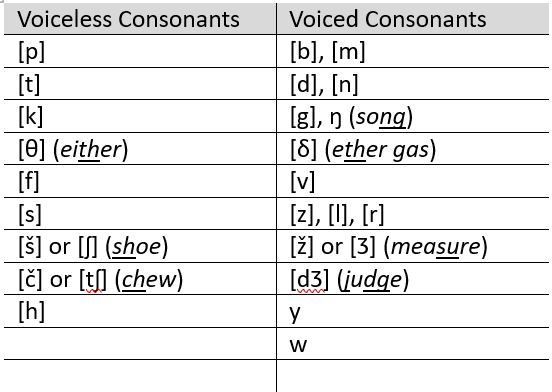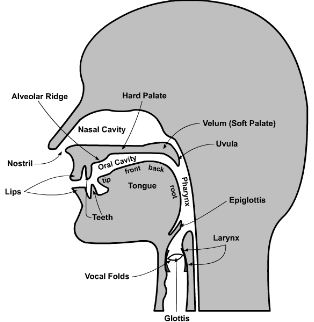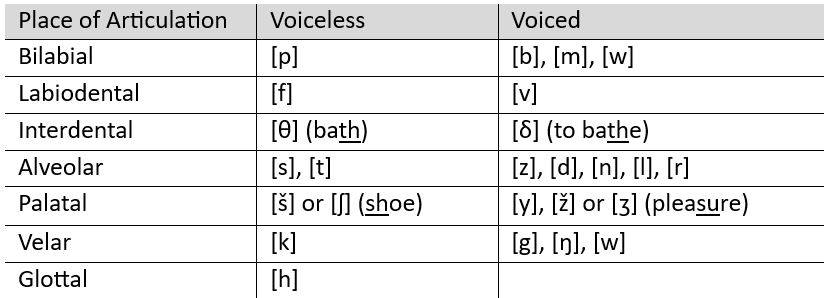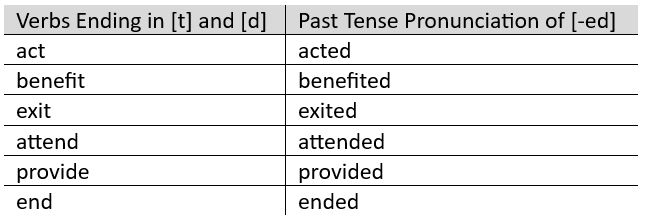2 Chapter 2 – Consonants
CONSONANTS
Consonant sounds are different from vowel sounds in one fundamental way. Consonants are pronounced with more constriction in the vocal tract than vowels. As air flows through the vocal tract, the tongue, lips, and other parts of the the vocal tract block the air to create friction or even to stop the airflow completely and then release it.
By the end of this chapter, the user will be able to…
- describe individual consonants
- produce individual consonants
- pronounce the -ed ending in three ways
- pronounce the -s ending in three ways
- link words together
Describing Consonants – Voicing, Place and Manner of Articulation
To organize the consonant sounds, we need to consider three key aspects of pronunciation: voicing, place of articulation, and manner of articulation. For a introduction, please watch this video by the linguist Evan Ashworth. The video uses the expression Articulatory Phonetics, which means how speech sounds are pronounced.
Voicing
Let’s begin with Voicing, which simply refers to vibration. Consonants that are produced with vibration are called voiced consonants. Voiceless consonants lack this vibration. Vibration occurs in the vocal folds also called vocal cords, which are in the throat.
Consider the difference between the sounds [f] and [v]. Lightly place your fingers on your throat and pronounce the [f] sound for five seconds. Without moving your fingers, now pronounce the [v] sound for five seconds. Do you notice the vibration? This vibration can be important to distinguishing words such as fast and vast. This vibration is also important in grammar such as the singular and plural in words like knife – knives, wolf – wolves, and leaf – leaves.
The list below contains voiceless and voiced consonants. Some phonetic symbols are needed because English spelling does not always distinguish voiceless and voiced consonants. For example, English has a voiceless “th” as in the word think. There is also a voiced “th,” which is the first sound in the word, those.
Voiceless and Voiced Consonants

Place of Articulation: Where Consonants are Produced
Consonants are produced in different places in the vocal tract. This image from madbeppo.com shows the vocal tract. We can use it to locate where consonants are produced. Knowing where consonants are produced makes them easier to pronounce.
The Vocal Tract

For example, three sounds that are produced with the upper and lower lips together are [p], [b], and [m]. Since they are produced with both lips, they are called bilabial.
Place of Articulation and Voicing for Consonants

The vocabulary describing the place of articulation is technical but easy to understand when looking at the vocal tract. Let’s consider sounds made with the teeth. These are called dental sounds. One category of dental sounds is called labiodental. These sounds are made with the teeth and the bottom lip to make the [f] and [v] sound. Interdental sounds are made with the tongue between the top and lower teeth.
The next important place for consonants is the alveolar ridge, which is located behind the top teeth. For example, the tongue moves to the little bump or ridge behind the top teeth to stop and then release the airflow to pronounce [t] or [d].
Palatal sounds are produced with the tongue almost touching the palate to create friction as in the words shoe and pleasure. Velar sounds are produced with the tongue moving back to the velum to block off airflow. All velar sounds are voiced except for [k].
The “lowest” part of the vocal tract is the glottis, which is the opening between the vocal cords. That is where the [h] sound is produced. The air flows through the glottis and the vocal cords come together slightly to make just a little friction. Then the air flows throughout the vocal tract and out of the mouth.
Manner of Articulation: How Consonants are Produced
Manner of articulation refers to how consonants are produced. The chart below shows six manners of articulation. English does not have voiceless nasals, liquids, or glides.
Manner of Articulation and Voicing for Consonants

The stop sounds are made by closing off or “stopping” the air flow and then releasing it again. One key to stop sounds is that we cannot hold the sound because it stops. As soon as it is spoken the sound stops.
Fricative sounds, on the other hand, can be held for as long as you have air and can produce friction. How long can you hold the sound [f] or [v]?
Affricates are stop sounds + fricative sounds. The result is a sound that has frication but cannot be held for long. For example, the stop sound [d] + the fricative [ʒ] come together to form the affricate [dʒ] as in the word judge.
Nasal sounds are produced when the airflow is allowed to go through the nasal cavity and nose. The nasal sounds are [m], [n], and [ŋ]. All English nasals are voiced.
Liquids and glides are also voiced sounds. The liquid sounds [l] and [r] and the glide sounds [w] and [y] or [j] can be difficult to pronounce in English. These are almost like vowel sounds and have little constriction in the vocal tract.
How the [h] Sound is Pronounced: Scroll back to the image of the vocal tract as you listen to the recording. The recording describes how the [h] sound is pronounced. It begins with the glottis, which is at the bottom of the vocal tract.
Why It Matters
Voicing, place of articulation, and manner of articulation matter because one small change can affect meaning and part of speech. For example, the verb buy and the noun pie are pronounced the same except that the [p] is voiceless and the [b] is voiced. The noun Paul and the adjective tall are also pronounced in the same way. The difference is the place of articulation. The [p] is a bilabial sound and the [t] is an alveolar sound. Finally, the adverb do and the noun zoo only differ in the manner or way the first sound is pronounced. The [d] is a stop and the [z] is a fricative.
Pronouncing the –ed Ending
The past tense –ed ending has three pronunciations: [-t], [-d], and [-Id]. Watch the video by Learn English Lab.com for an introduction.
Learn English Lab
The rule for pronouncing past tense –ed as [-t] and [-d] is simple.
- If the verb ends in a voiceless consonant, the [-ed] is pronounced as [-t], which is also voiceless.
- If the verb ends in a voiced sound, then –ed is pronounced as [-d], which is voiced.


The rule for pronouncing past tense –ed as [-Id] is also simple.
- When the verb ends in [t] or [d], the -ed ending is pronounced as [Id].

Pronouncing the –s Ending: Plural Nouns, Singular Verbs, Contractions, and Possessives
The –s ending is important in English grammar. It is used to make the regular plural in nouns, third person singular in verbs, and the possessive.
The –s ending is pronounced different ways depending on the last sound of the word. Here are the rules:
- If the word ends in a voiceless consonant, the –s ending is pronounced as [s].
- If the word ends in a voiced consonant, the –s ending is pronounced as [z].
- If the word ends in a sibilant or “hissing sound” such as [s], [z], [tʃ], [ʃ], or [dʒ]
then the -s ending is pronounced as [ιz].

This video from The Sounds American Channel offers a short introduction and many examples of pronouncing the –s ending on nouns.
Linking Consonants and Vowels
It is typical in North American speech to link the end of one word with the beginning of another word. Linking sounds this way connects the words to sound more fluent.
Consonant-Vowel Linking
Consonant-vowel linking happens when one word ends with a consonant and the next word begins with a vowel. An example is in the phrase, stand up! When the [d] links to the [u], the syllables rearrange. Instead of pronouncing the syllables as stand + up , linking creates stan + dup.
Vowel-Vowel Linking with [y] or [w]
Vowels can also link with vowels. Linking happens with the vowel offglides [y] or [w]. Recall from Chapter 1 that the tense vowels are actually pronounced as [iy], [ey], uw], and [ow].
Consider the phrase “see it” or [siy] [ιt]. When the [y] links to the [ι], the phrase is pronounced as see-yit.
Here is an example of linking with the back vowel [ow] in the sentence “go away.” The word go is pronounced as [gow] and the [w] links with the next word. The result is go wa way.
This video from the American English Channel (americanenglish.state.gov) gives more information and more examples of consonant-vowel and vowel-vowel linking.
Consonant to Consonant Linking
In this video from Rachel’s English.com, the speaker discusses linking Consonants.
Same Consonants: The first example is linking the same consonants as in the phrases “gas station” and “some might.” The [s] at the end of the word links to the [s] at the beginning of the next word making one long [s] sound instead of two [s] sounds. The same kind of linking happens in the next example. The [m] sounds link and create one long [m] sound rather than two [m] sounds.
- gas station
- some might think so
Stop Consonants: The next examples show how stop consonants are linked. The key to linking stop consonants is to stop the airflow and then start it again. The speaker gives these examples:
- hot today
- bad dog
- peanut butter
- flip phone
- hot sauce
The video includes five ways to practice consonant-consonant linking.
- Isolate the sounds
- practice the sounds separately
- practice the sounds together, slowly
- Speed up
- Put the sounds and word back into the context to give the words meaning.

